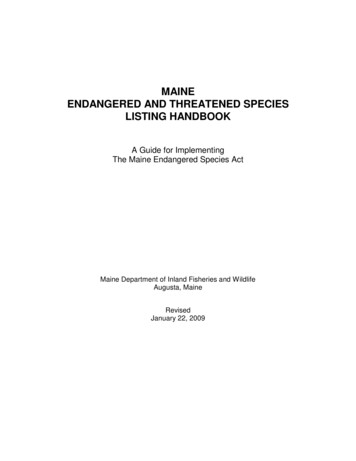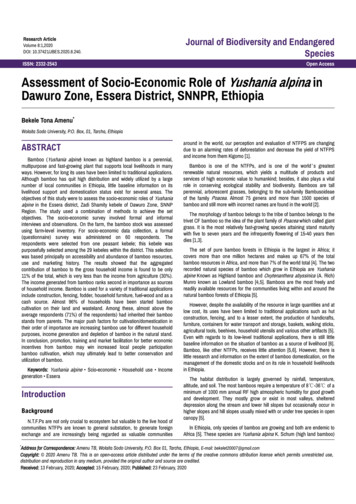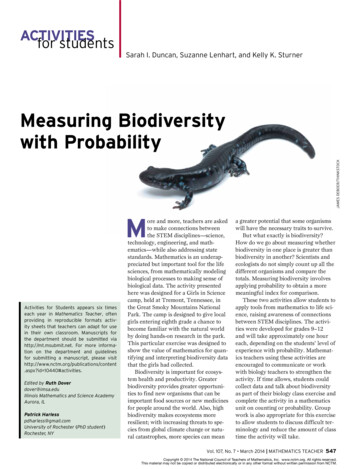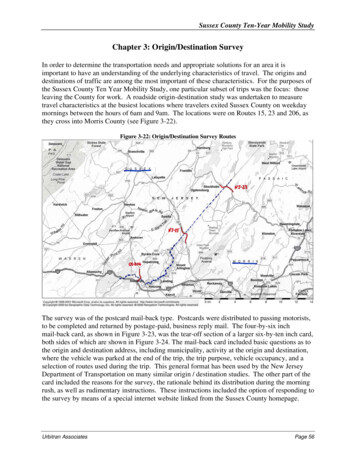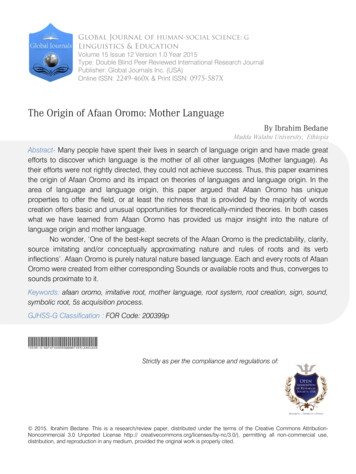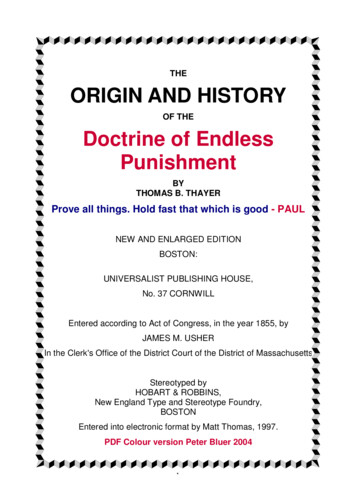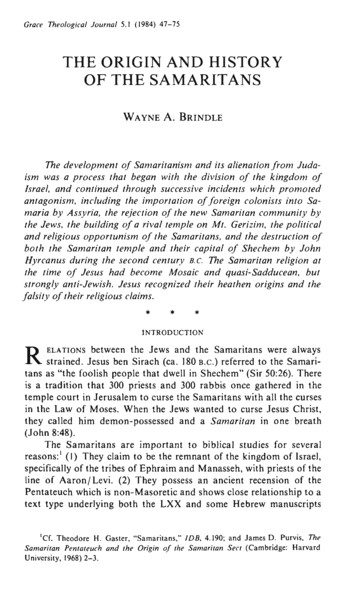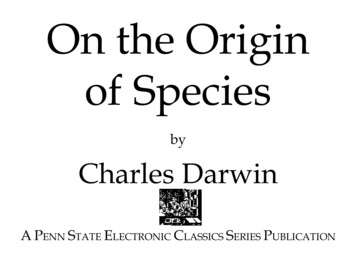
Transcription
On the Originof SpeciesbyCharles DarwinA PENN STATE ELECTRONIC CLASSICS SERIES PUBLICATION
On the Origin of Species by Charles Darwin is a publication of the Pennsylvania StateUniversity. This Portable Document file is furnished free and without any charge of anykind. Any person using this document file, for any purpose, and in any way does so athis or her own risk. Neither the Pennsylvania State University nor Jim Manis, FacultyEditor, nor anyone associated with the Pennsylvania State University assumes any responsibility for the material contained within the document or for the file as an electronic transmission, in any way.On the Origin of Species by Charles Darwin, the Pennsylvania State University, ElectronicClassics Series, Jim Manis, Faculty Editor, Hazleton, PA 18202-1291 is a Portable Document File produced as part of an ongoing student publication project to bring classicalworks of literature, in English, to free and easy access of those wishing to make use ofthem.Cover Design: Jim ManisCopyright 2001 The Pennsylvania State UniversityThe Pennsylvania State University is an equal opportunity university.
Charles DarwinOn the Originof Speciestoo well studied in the book of God’s word, or in thebook of God’s works; divinity or philosophy; butrather let men endeavour an endless progress orproficience in both.’Bacon: Advancement of Learning.byDown, Bromley, Kent,October 1st, 1859.Charles DarwinOn the Origin of Species by Means of Natural Selection, or the Preservation of Favoured Races in theStruggle for Life.‘But with regard to the material world, we can atleast go so far as this—we can perceive that eventsare brought about not by insulated interpositions ofDivine power, exerted in each particular case, butby the establishment of general laws.’ByCharles DarwinW. Whewell: Bridgewater Treatise.‘To conclude, therefore, let no man out of a weakconceit of sobriety, or an ill-applied moderation,think or maintain, that a man can search too far or be3
On the Origin of SpeciesContentsChapter IIIntroductionVariation under NatureChapter IVariability — Individual Differences — Doubtfulspecies — Wide ranging, much diffused, and common species vary most — Species of the larger genera in any country vary more than the species of thesmaller genera — Many of the species of the largergenera resemble varieties in being very closely, butunequally, related to each other, and in having restricted ranges.Variation under DomesticationCauses of Variability — Effects of Habit — Correlation of Growth —Inheritance — Character of Domestic Varieties — Difficulty of distinguishing betweenVarieties and Species — Origin of Domestic Varieties from one or more Species — Domestic Pigeons,their Differences and Origin — Principle of Selection anciently followed, its Effects —Methodical andUnconscious Selection — Unknown Origin of ourDomestic Productions — Circumstances favourableto Man’s power of Selection.Chapter IIIStruggle for ExistenceBears on natural selection — The term used in a widesense — Geometrical powers of increase — Rapidincrease of naturalised animals and plants —Natureof the checks to increase — Competition universal4
Charles Darwin— Effects of climate — Protection from the numberof individuals — Complex relations of all animalsand plants throughout nature — Struggle for lifemost severe between individuals and varieties of thesame species; often severe between species of thesame genus — The relation of organism to organismthe most important of all relations.acter, related to the diversity of inhabitants of anysmall area, and to naturalisation — Action of Natural Selection, through Divergence of Character andExtinction, on the descendants from a common parent — Explains the Grouping of all organic beings.Chapter IVLaws of VariationNatural SelectionEffects of external conditions — Use and disuse, combined with natural selection; organs of flight and ofvision — Acclimatisation — Correlation of growth— Compensation and economy of growth — Falsecorrelations —Multiple, rudimentary, and lowlyorganised structures variable — Parts developed inan unusual manner are highly variable: specific characters more variable than generic: secondary sexualcharacters variable —Species of the same genus varyin an analogous manner — Reversions to long-lostcharacters — Summary.Chapter VNatural Selection — its power compared with man’sselection — its power on characters of trifling importance — its power at all ages and on both sexes— Sexual Selection — On the generality of intercrosses between individuals of the same species —Circumstances favourable and unfavourable to Natural Selection, namely, intercrossing, isolation, number of individuals — Slow action — Extinctioncaused by Natural Selection —Divergence of Char5
On the Origin of SpeciesChapter VIChapter VIIDifficulties on TheoryInstinctDifficulties on the theory of descent with modification — Transitions —Absence or rarity of transitionalvarieties — Transitions in habits of life — Diversified habits in the same species — Species with habits widely different from those of their allies — Organs of extreme perfection — Means of transition —Cases of difficulty — Natura non facit saltum —Organs of small importance — Organs not in all casesabsolutely perfect —The law of Unity of Type andof the Conditions of Existence embraced by thetheory of Natural Selection.Instincts comparable with habits, but different in theirorigin —Instincts graduated — Aphides and ants —Instincts variable — Domestic instincts, their origin— Natural instincts of the cuckoo, ostrich, and parasitic bees — Slave-making ants — Hive-bee, its cellmaking instinct — Difficulties on the theory of theNatural Selection of instincts —Neuter or sterile insects — Summary.Chapter VIIIHybridismDistinction between the sterility of first crosses andof hybrids —Sterility various in degree, not universal, affected by close interbreeding, removed by domestication — Laws governing the sterility of hy6
Charles Darwinbrids — Sterility not a special endowment, but incidental on other differences — Causes of the sterilityof first crosses and of hybrids —Parallelism betweenthe effects of changed conditions of life and crossing— Fertility of varieties when crossed and of theirmongrel offspring not universal — Hybrids andmongrels compared independently of their fertility— Summary.sudden appearance of groups of species — On theirsudden appearance in the lowest known fossiliferous strata.Chapter XOn the Geological Succession of Organic BeingsOn the slow and successive appearance of new species — On their different rates of change — Speciesonce lost do not reappear — Groups of species follow the same general rules in their appearance anddisappearance as do single species — On Extinction— On simultaneous changes in the forms of lifethroughout the world — On the affinities of extinctspecies to each other and to living species — On thestate of development of ancient forms — On the succession of the same types within the same areas —Summary of preceding and present chapters.Chapter IXOn the Imperfection of the Geological RecordOn the absence of intermediate varieties at thepresent day — On the nature of extinct intermediatevarieties; on their number — On the vast lapse oftime, as inferred from the rate of deposition and ofdenudation —On the poorness of ourpalaeontological collections — On the intermittenceof geological formations — On the absence of intermediate varieties in any one formation — On the7
On the Origin of SpeciesChapter XIsource with subsequent modification —Summary ofthe last and present chapters.Geographical DistributionChapter XIIIPresent distribution cannot be accounted for by differences in physical conditions — Importance of barriers — Affinity of the productions of the same continent — Centres of creation — Means of dispersal,by changes of climate and of the level of the land,and by occasional means — Dispersal during theGlacial period co-extensive with the world.Mutual Affinities of Organic Beings:Morphology: Embryology: Rudimentary OrgansClassification, groups subordinate to groups —Natural system — Rules and difficulties in classification, explained on the theory of descent with modification — Classification of varieties — Descent always used in classification — Analogical or adaptive characters — Affinities, general, complex andradiating — Extinction separates and defines groups—Morphology, between members of the same class,between parts of the same individual — Embryology, laws of, explained by variations not supervening at an early age, and being inherited at a corresponding age — Rudimentary Organs; their originexplained — Summary.Chapter XIIGeographical Distribution — continuedDistribution of fresh-water productions — On theinhabitants of oceanic islands — Absence of Batrachians and of terrestrial Mammals — On the relation of the inhabitants of islands to those of the nearest mainland —On colonisation from the nearest8
Charles DarwinOn the Origin of Species.Chapter XIVRecapitulation and ConclusionIntroduction.WRecapitulation of the difficulties on the theory ofNatural Selection —Recapitulation of the general andspecial circumstances in its favour —Causes of thegeneral belief in the immutability of species — Howfar the theory of natural selection may be extended— Effects of its adoption on the study of Natural history — Concluding remarks.H.M.S. ‘BEAGLE,’ as naturalist, I was much struck with certainfacts in the distribution of the inhabitants of South America, and in the geological relations of the present to the past inhabitants of thatcontinent. These facts seemed to me to throw somelight on the origin of species—that mystery of mysteries, as it has been called by one of our greatestphilosophers. On my return home, it occurred to me,in 1837, that something might perhaps be made outon this question by patiently accumulating and reflecting on all sorts of facts which could possibly haveany bearing on it. After five years’ work I allowedmyself to speculate on the subject, and drew up someshort notes; these I enlarged in 1844 into a sketch ofthe conclusions, which then seemed to me probable:from that period to the present day I have steadilyHEN ON BOARD9
On the Origin of Speciespursued the same object. I hope that I may be excused for entering on these personal details, as I givethem to show that I have not been hasty in coming toa decision.My work is now nearly finished; but as it will takeme two or three more years to complete it, and asmy health is far from strong, I have been urged topublish this Abstract. I have more especially beeninduced to do this, as Mr. Wallace, who is now studying the natural history of the Malay archipelago, hasarrived at almost exactly the same general conclusions that I have on the origin of species. Last yearhe sent to me a memoir on this subject, with a request that I would forward it to Sir Charles Lyell,who sent it to the Linnean Society, and it is publishedin the third volume of the Journal of that Society. SirC. Lyell and Dr. Hooker, who both knew of mywork—the latter having read my sketch of 1844—honoured me by thinking it advisable to publish,with Mr. Wallace’s excellent memoir, some brief extracts from my manuscripts.This Abstract, which I now publish, must necessarily be imperfect. I cannot here give references andauthorities for my several statements; and I musttrust to the reader reposing some confidence in myaccuracy. No doubt errors will have crept in, thoughI hope I have always been cautious in trusting togood authorities alone. I can here give only the general conclusions at which I have arrived, with a fewfacts in illustration, but which, I hope, in most caseswill suffice. No one can feel more sensible than I doof the necessity of hereafter publishing in detail allthe facts, with references, on which my conclusionshave been grounded; and I hope in a future work todo this. For I am well aware that scarcely a singlepoint is discussed in this volume on which facts cannot be adduced, often apparently leading to conclusions directly opposite to those at which I have arrived. A fair result can be obtained only by fully stating and balancing the facts and arguments on bothsides of each question; and this cannot possibly behere done.10
Charles DarwinI much regret that want of space prevents my having the satisfaction of acknowledging the generousassistance which I have received from very manynaturalists, some of them personally unknown to me.I cannot, however, let this opportunity pass withoutexpressing my deep obligations to Dr. Hooker, whofor the last fifteen years has aided me in every possible way by his large stores of knowledge and hisexcellent judgment.In considering the Origin of Species, it is quite conceivable that a naturalist, reflecting on the mutualaffinities of organic beings, on their embryologicalrelations, their geographical distribution, geological succession, and other such facts, might come tothe conclusion that each species had not been independently created, but had descended, like varieties, from other species. Nevertheless, such a conclusion, even if well founded, would be unsatisfactory,until it could be shown how the innumerable species inhabiting this world have been modified, so asto acquire that perfection of structure and coadapta-tion which most justly excites our admiration. Naturalists continually refer to external conditions, suchas climate, food, &c., as the only possible cause ofvariation. In one very limited sense, as we shall hereafter see, this may be true; but it is preposterous toattribute to mere external conditions, the structure,for instance, of the woodpecker, with its feet, tail,beak, and tongue, so admirably adapted to catch insects under the bark of trees. In the case of themisseltoe, which draws its nourishment from certaintrees, which has seeds that must be transported bycertain birds, and which has flowers with separatesexes absolutely requiring the agency of certain insects to bring pollen from one flower to the other, itis equally preposterous to account for the structureof this parasite, with its relations to several distinctorganic beings, by the effects of external conditions,or of habit, or of the volition of the plant itself.The author of the ‘Vestiges of Creation’ would, Ipresume, say that, after a certain unknown numberof generations, some bird had given birth to a wood11
On the Origin of Speciespecker, and some plant to the misseltoe, and thatthese had been produced perfect as we now see them;but this assumption seems to me to be no explanation, for it leaves the case of the coadaptations of organic beings to each other and to their physical conditions of life, untouched and unexplained.It is, therefore, of the highest importance to gain aclear insight into the means of modification and coadaptation. At the commencement of my observations it seemed to me probable that a careful studyof domesticated animals and of cultivated plantswould offer the best chance of making out this obscure problem. Nor have I been disappointed; in thisand in all other perplexing cases I have invariablyfound that our knowledge, imperfect though it be,of variation under domestication, afforded the bestand safest clue. I may venture to express my conviction of the high value of such studies, although theyhave been very commonly neglected by naturalists.From these considerations, I shall devote the firstchapter of this Abstract to Variation under Domesti-cation. We shall thus see that a large amount of hereditary modification is at least possible, and, whatis equally or more important, we shall see how greatis the power of man in accumulating by his Selection successive slight variations. I will then pass onto the variability of species in a state of nature; but Ishall, unfortunately, be compelled to treat this subject far too briefly, as it can be treated properly onlyby giving long catalogues of facts. We shall, however, be enabled to discuss what circumstances aremost favourable to variation. In the next chapter theStruggle for Existence amongst all organic beingsthroughout the world, which inevitably follows fromtheir high geometrical powers of increase, will betreated of. This is the doctrine of Malthus, appliedto the whole animal and vegetable kingdoms. Asmany more individuals of each species are born thancan possibly survive; and as, consequently, there isa frequently recurring struggle for existence, it follows that any being, if it vary however slightly inany manner profitable to itself, under the complex12
Charles Darwinand sometimes varying conditions of life, will havea better chance of surviving, and thus be naturallyselected. From the strong principle of inheritance,any selected variety will tend to propagate its newand modified form.This fundamental subject of Natural Selection willbe treated at some length in the fourth chapter; andwe shall then see how Natural Selection almost inevitably causes much Extinction of the less improvedforms of life and induces what I have called Divergence of Character. In the next chapter I shall discuss the complex and little known laws of variationand of correlation of growth. In the four succeedingchapters, the most apparent and gravest difficultieson the theory will be given: namely, first, the difficulties of transitions, or in understanding how asimple being or a simple organ can be changed andperfected into a highly developed being or elaborately constructed organ; secondly the subject of Instinct, or the mental powers of animals, thirdly, Hybridism, or the infertility of species and the fertilityof varieties when intercrossed; and fourthly, the imperfection of the Geological Record. In the next chapter I shall consider the geological succession of organic beings throughout time; in the eleventh andtwelfth, their geographical distribution throughoutspace; in the thirteenth, their classification or mutual affinities, both when mature and in an embryonic condition. In the last chapter I shall give a briefrecapitulation of the whole work, and a few concluding remarks.No one ought to feel surprise at much remainingas yet unexplained in regard to the origin of speciesand varieties, if he makes due allowance for our profound ignorance in regard to the mutual relations ofall the beings which live around us. Who can explainwhy one species ranges widely and is very numerous, and why another allied species has a narrowrange and is rare? Yet these relations are of the highest importance, for they determine the present welfare, and, as I believe, the future success and modification of every inhabitant of this world. Still less do13
On the Origin of SpeciesChapter Iwe know of the mutual relations of the innumerableinhabitants of the world during the many past geological epochs in its history. Although much remainsobscure, and will long remain obscure, I can entertain no doubt, after the most deliberate study anddispassionate judgment of which I am capable, thatthe view which most naturalists entertain, and whichI formerly entertained—namely, that each species hasbeen independently created—is erroneous. I am fullyconvinced that species are not immutable; but thatthose belonging to what are called the same generaare lineal descendants of some other and generallyextinct species, in the same manner as the acknowledged varieties of any one species are the descendants of that species. Furthermore, I am convincedthat Natural Selection has been the main but not exclusive means of modification.Variation under DomesticationCauses of Variability — Effects of Habit — Correlation of Growth —Inheritance — Character of Domestic Varieties — Difficulty of distinguishing betweenVarieties and Species — Origin of Domestic Varieties from one or more Species — Domestic Pigeons,their Differences and Origin — Principle of Selection anciently followed, its Effects —Methodical andUnconscious Selection — Unknown Origin of ourDomestic Productions — Circumstances favourableto Man’s power of Selection.WHEN WE LOOK to the individuals of the same varietyor sub-variety of our older cultivated plants andanimals, one of the first points which strikes us, is,that they generally differ much more from each other,than do the individuals of any one species or variety in a state of nature. When we reflect on the vast14
Charles Darwindiversity of the plants and animals which have beencultivated, and which have varied during all agesunder the most different climates and treatment, Ithink we are driven to conclude that this greater variability is simply due to our domestic productionshaving been raised under conditions of life not souniform as, and somewhat different from, those towhich the parent-species have been exposed undernature. There is, also, I think, some probability inthe view propounded by Andrew Knight, that thisvariability may be partly connected with excess offood. It seems pretty clear that organic beings mustbe exposed during several generations to the newconditions of life to cause any appreciable amountof variation; and that when the organisation has oncebegun to vary, it generally continues to vary for manygenerations. No case is on record of a variable beingceasing to be variable under cultivation. Our oldestcultivated plants, such as wheat, still often yield newvarieties: our oldest domesticated animals are stillcapable of rapid improvement or modification.It has been disputed at what period of life thecauses of variability, whatever they may be, generally act; whether during the early or late period ofdevelopment of the embryo, or at the instant of conception. Geoffroy St. Hilaire’s experiments show thatunnatural treatment of the embryo causes monstrosities; and monstrosities cannot be separated by anyclear line of distinction from mere variations. But Iam strongly inclined to suspect that the most frequent cause of variability may be attributed to themale and female reproductive elements having beenaffected prior to the act of conception. Several reasons make me believe in this; but the chief one is theremarkable effect which confinement or cultivationhas on the functions of the reproductive system; thissystem appearing to be far more susceptible thanany other part of the organisation, to the action ofany change in the conditions of life. Nothing is moreeasy than to tame an animal, and few things moredifficult than to get it to breed freely under confinement, even in the many cases when the male and15
On the Origin of Speciesfemale unite. How many animals there are which willnot breed, though living long under not very closeconfinement in their native country! This is generally attributed to vitiated instincts; but how manycultivated plants display the utmost vigour, and yetrarely or never seed! In some few such cases it hasbeen found out that very trifling changes, such as alittle more or less water at some particular period ofgrowth, will determine whether or not the plant setsa seed. I cannot here enter on the copious detailswhich I have collected on this curious subject; but toshow how singular the laws are which determine thereproduction of animals under confinement, I mayjust mention that carnivorous animals, even from thetropics, breed in this country pretty freely under confinement, with the exception of the plantigrades orbear family; whereas, carnivorous birds, with therarest exceptions, hardly ever lay fertile eggs. Manyexotic plants have pollen utterly worthless, in thesame exact condition as in the most sterile hybrids.When, on the one hand, we see domesticated ani-mals and plants, though often weak and sickly, yetbreeding quite freely under confinement; and when,on the other hand, we see individuals, though takenyoung from a state of nature, perfectly tamed, longlived, and healthy (of which I could give numerousinstances), yet having their reproductive system soseriously affected by unperceived causes as to failin acting, we need not be surprised at this system,when it does act under confinement, acting not quiteregularly, and producing offspring not perfectly liketheir parents or variable.Sterility has been said to be the bane of horticulture; but on this view we owe variability to the samecause which produces sterility; and variability is thesource of all the choicest productions of the garden.I may add, that as some organisms will breed mostfreely under the most unnatural conditions (for instance, the rabbit and ferret kept in hutches), showing that their reproductive system has not been thusaffected; so will some animals and plants withstanddomestication or cultivation, and vary very16
Charles Darwinslightly—perhaps hardly more than in a state of nature.A long list could easily be given of ‘sporting plants;’by this term gardeners mean a single bud or offset,which suddenly assumes a new and sometimes verydifferent character from that of the rest of the plant.Such buds can be propagated by grafting, &c., andsometimes by seed. These ‘sports’ are extremely rareunder nature, but far from rare under cultivation;and in this case we see that the treatment of the parent has affected a bud or offset, and not the ovulesor pollen. But it is the opinion of most physiologiststhat there is no essential difference between a budand an ovule in their earliest stages of formation; sothat, in fact, ‘sports’ support my view, that variability may be largely attributed to the ovules or pollen,or to both, having been affected by the treatment ofthe parent prior to the act of conception. These casesanyhow show that variation is not necessarily connected, as some authors have supposed, with the actof generation.Seedlings from the same fruit, and the young ofthe same litter, sometimes differ considerably fromeach other, though both the young and the parents,as Muller has remarked, have apparently been exposed to exactly the same conditions of life; and thisshows how unimportant the direct effects of the conditions of life are in comparison with the laws of reproduction, and of growth, and of inheritance; forhad the action of the conditions been direct, if any ofthe young had varied, all would probably have varied in the same manner. To judge how much, in thecase of any variation, we should attribute to the direct action of heat, moisture, light, food, &c., is mostdifficult: my impression is, that with animals suchagencies have produced very little direct effect,though apparently more in the case of plants. Underthis point of view, Mr. Buckman’s recent experimentson plants seem extremely valuable. When all ornearly all the individuals exposed to certain conditions are affected in the same way, the change at firstappears to be directly due to such conditions; but in17
On the Origin of Speciessome cases it can be shown that quite opposite conditions produce similar changes of structure. Nevertheless some slight amount of change may, I think, beattributed to the direct action of the conditions of life—as, in some cases, increased size from amount of food,colour from particular kinds of food and from light,and perhaps the thickness of fur from climate.Habit also has a deciding influence, as in the period of flowering with plants when transported fromone climate to another. In animals it has a moremarked effect; for instance, I find in the domesticduck that the bones of the wing weigh less and thebones of the leg more, in proportion to the wholeskeleton, than do the same bones in the wild-duck;and I presume that this change may be safely attributed to the domestic duck flying much less, andwalking more, than its wild parent. The great andinherited development of the udders in cows andgoats in countries where they are habitually milked,in comparison with the state of these organs in othercountries, is another instance of the effect of use. Nota single domestic animal can be named which has notin some country drooping ears; and the view suggested by some authors, that the drooping is due tothe disuse of the muscles of the ear, from the animalsnot being much alarmed by danger, seems probable.There are many laws regulating variation, somefew of which can be dimly seen, and will be hereafter briefly mentioned. I will here only allude to whatmay be called correlation of growth. Any change inthe embryo or larva will almost certainly entailchanges in the mature animal. In monstrosities, thecorrelations between quite distinct parts are verycurious; and many instances are given in IsidoreGeoffroy St. Hilaire’s great work on this subject.Breeders believe that long limbs are almost alwaysaccompanied by an elongated head. Some instancesof correlation are quite whimsical; thus cats with blueeyes are invariably deaf; colour and constitutionalpeculiarities go together, of which many remarkablecases could be given amongst animals and plants.From the facts collected by Heusinger, it appears that18
Charles Darwinwhite sheep and pigs are differently affected fromcoloured individuals by certain vegetable poisons.Hairless dogs have imperfect teeth; long-haired andcoarse-haired animals are apt to have, as is asserted,long or many horns; pigeons with feathered feethave skin between their outer toes; pigeons withshort beaks have small feet, and those with longbeaks large feet. Hence, if man goes on selecting,and thus augmenting, any peculiarity, he will almost certainly unconsciously modify other parts ofthe structure, owing to the mysterious laws of thecorrelation of growth.The result of the various, quite unknown, or dimlyseen laws of variation is infinitely complex and diversified. It is well worth while carefully to studythe several treatises published on some of our oldcultivated plants, as on the hyacinth, potato, eventhe dahlia, &c.; and it is really surprising to note theendless points in structure and constitution in whichthe varieties and sub-varieties differ slightly fromeach other. The w
light on the origin of species—that mystery of mys-teries, as it has been called by one of our greatest philosophers. On my return home, it occurred to me, in 1837, that something might perhaps be made out on this question by patiently accumulating and re-flecting on all so
